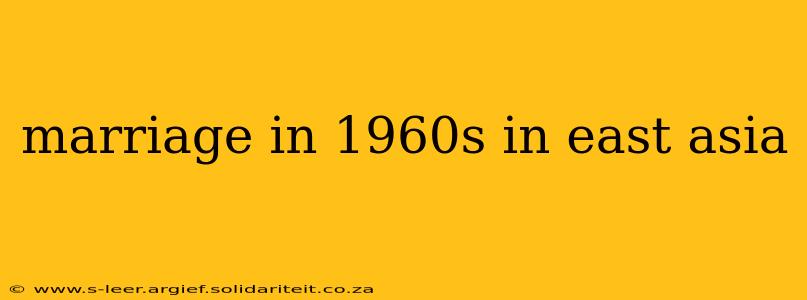The 1960s in East Asia witnessed a fascinating interplay between deeply rooted traditions and the burgeoning winds of modernization, profoundly shaping the landscape of marriage. While generalizations across such a diverse region are inherently risky, certain common threads and significant regional variations characterized marital practices during this decade. This exploration delves into the complexities of marriage in East Asia during the 1960s, examining the factors that influenced marital norms and the evolving perspectives on family life.
What were the common marriage practices in East Asia in the 1960s?
Marriage in the 1960s across East Asia remained largely arranged or semi-arranged, especially in rural areas. Families played a crucial role in selecting spouses, prioritizing factors like lineage, social standing, and economic compatibility. While love matches were not unheard of, they were often less common than unions forged through familial negotiations. Dowries, though their significance varied across regions, remained a prevalent aspect of many marriages, reflecting the economic considerations that underpinned these unions. Traditional ceremonies, steeped in cultural and religious significance, accompanied the marital union, varying considerably across countries and communities.
How did the role of women in marriage change during the 1960s in East Asia?
The role of women in marriage during the 1960s in East Asia continued to be largely defined by patriarchal structures. Women were primarily expected to manage the household, raise children, and support their husbands. However, the seeds of change were sown during this decade. Increased access to education and, in some areas, burgeoning employment opportunities began to subtly challenge the traditional subservient role of women. This shift, while gradual and uneven, marked a crucial first step toward greater gender equality in the decades to come.
How did economic factors influence marriage in East Asia during the 1960s?
Economic factors significantly impacted marriage in East Asia during this era. The post-war economic recovery, coupled with the beginnings of industrialization in some parts of the region, started altering traditional marriage patterns. In urban areas, rising economic opportunities influenced the age at which people married and the increasing importance of individual financial stability in partner selection. Rural areas, however, remained largely tied to agricultural livelihoods, where arranged marriages based on land ownership and economic security continued to dominate.
What were the different approaches to marriage across different East Asian countries in the 1960s?
While certain common threads wove through East Asian marriage practices in the 1960s, significant variations existed between countries. Japan, for instance, experienced a period of increasing urbanization and Western influence, leading to a gradual shift toward more individualistic choices in marriage. In contrast, more rural and less industrialized countries may have retained more traditional arranged marriage practices. China, emerging from the tumultuous period of the Cultural Revolution, experienced a complex restructuring of social norms, influencing marital practices in ways that differed significantly from other East Asian nations. Understanding these national variations requires individual analysis of specific socio-economic conditions in each country.
How did the 1960s influence marriage trends in East Asia in later decades?
The 1960s in East Asia served as a pivotal decade, laying the groundwork for significant transformations in marriage patterns that would continue to evolve in subsequent years. The seeds of change planted—greater access to education for women, economic diversification, and the gradual erosion of rigid patriarchal structures—laid the foundation for a more nuanced and diverse approach to marriage in later decades. While traditional practices persisted, the winds of modernity were increasingly shaping perceptions and practices relating to marital unions, leading to a more complex and evolving landscape in the years to come.
Disclaimer: This article provides a broad overview of marriage in East Asia during the 1960s. The complexities and variations across countries and regions are immense, and further research is encouraged for a more in-depth understanding of specific national contexts.
